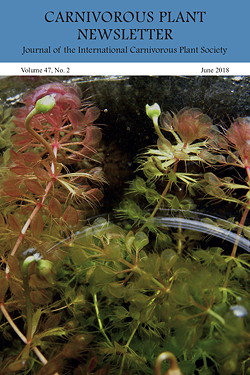International Carnivorous Plant Society
Carnivorous Plant Newsletter Archive
Germination rate and longevity of seeds of Aldrovanda vesiculosa and Utricularia vulgaris
Lubomír Adamec
Carniv. Pl. Newslett. 47(2):64-69
Published 10 May 2018
https://doi.org/10.55360/cpn472.la793
Summary
The ecological group of aquatic carnivorous plants includes monotypic Aldrovanda vesiculosa L. (Droseraceae) and around 60 species of Utricularia L. (Lentibulariaceae). Although the majority of aquatic carnivorous species are perennials and propagate mainly vegetatively by branching, shoot fragmentation and turions, the majority of them also set seeds (Taylor 1989; Cross 2012; Cross et al. 2016, 2018). While these modes of vegetative propagation in temperate species ensure the production of high plant biomass at sites during each season and turions also serve population overwintering (Adamec 1999a, 2011), functional seeds form a viable seed bank as a safety measure to overcome crucial habitat disturbances (mainly drought) leading to biomass extinction and are usually spread by water birds to colonize new potential distant sites (Santamaria 2002; Cross 2012; Cross et al. 2016, 2018).
Keywords: Aldrovanda vesiculosa, Utricularia vulgaris, aquatic carnivorous plants, field bag experiment, seed germination, life-span, seed bank
Article Citation
Lubomír Adamec. 2018. Germination rate and longevity of seeds of Aldrovanda vesiculosa and Utricularia vulgaris. Carniv. Pl. Newslett. 47(2):64-69. https://doi.org/10.55360/cpn472.la793
Page views: 1054
©2025 International Carnivorous Plant Society
www.carnivorousplants.org
This page is maintained by John Brittnacher.
Please contact us at our membership website, icps.clubexpress.com.
Privacy: The Carnivorous Plant Newsletter Archive website does not track users.

